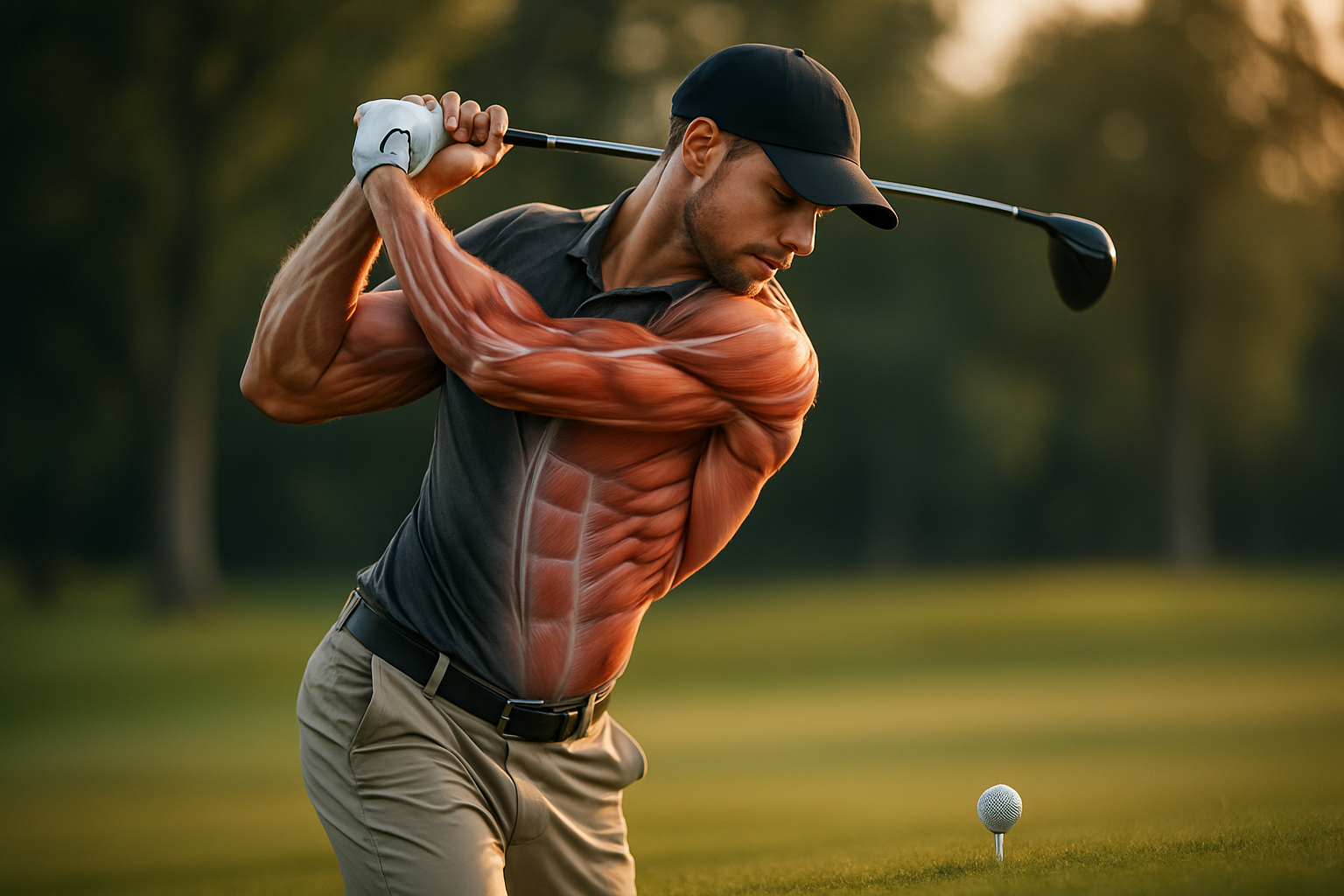Biomechanics of the Perfect Golf Swing
The enigmatic pursuit of the perfect golf swing has captivated players and scientists alike for generations. This elusive combination of power, precision, and grace represents the pinnacle of golfing prowess, sought after by amateurs and professionals with equal fervor. But what exactly constitutes the ideal swing? Is it purely a matter of technique, or does science play a crucial role in unraveling its mysteries?

The Foundation: Understanding Golf Swing Mechanics
At its core, the golf swing is a rotational movement designed to transfer energy from the player’s body to the golf ball. This transfer occurs through a series of coordinated movements, beginning with the backswing, transitioning through the downswing, and culminating in the impact and follow-through phases.
The backswing initiates the movement, with the golfer rotating their upper body away from the target while maintaining a stable lower body. This creates potential energy, much like drawing back a bow. The transition from backswing to downswing is a critical moment, as it sets the stage for the power generation to come.
During the downswing, the golfer’s body uncoils, starting with the hips and progressing up through the torso, arms, and finally the club. This sequential rotation, known as the kinematic sequence, is crucial for maximizing clubhead speed at impact. The follow-through completes the motion, allowing for a smooth deceleration and helping to direct the ball’s flight.
The Role of Kinetic Chain in Power Generation
The concept of the kinetic chain is fundamental to understanding the biomechanics of the golf swing. This principle describes how energy is transferred through interconnected body segments, from the ground up through the golfer’s body and into the club.
The kinetic chain in golf begins with the feet pushing against the ground, creating a reactive force that travels up through the legs, hips, torso, arms, and finally into the club. This sequential activation of body segments allows for the accumulation and transfer of energy, resulting in maximum clubhead speed at the point of impact.
Research has shown that professional golfers exhibit a more efficient kinetic chain compared to amateurs. They demonstrate better coordination between body segments, with each link in the chain activating at the optimal time to maximize energy transfer. This efficiency not only increases power but also improves consistency and reduces the risk of injury.
The X-Factor: Maximizing Torso-Pelvic Separation
One of the most crucial elements in generating power in the golf swing is the concept of the X-Factor. This term refers to the difference in rotation between the shoulders and hips at the top of the backswing. A larger X-Factor creates more potential energy and allows for a more explosive downswing.
Studies have shown that professional golfers typically achieve a greater X-Factor than amateurs, often exceeding 45 degrees of separation. This increased rotation creates a “loaded spring” effect in the body, with the muscles of the core and torso stretched and primed for a powerful release.
However, it’s important to note that the X-Factor is not just about achieving maximum rotation. The timing of when this separation occurs is equally crucial. The most effective swings maintain this separation into the early stages of the downswing, a phenomenon known as X-Factor stretch. This delayed release of torso rotation relative to hip rotation allows for even greater power accumulation before impact.
The Importance of Ground Reaction Forces
While much attention is paid to the upper body in golf swing analysis, the interaction between the golfer’s feet and the ground plays a critical role in power generation. Ground reaction forces (GRFs) are the forces exerted by the ground on the body in response to the forces the body exerts on the ground.
In the golf swing, effective use of GRFs allows the golfer to create a stable base from which to rotate and generate power. Research has shown that professional golfers exhibit distinct patterns of GRF utilization throughout the swing:
-
During the backswing, weight tends to shift towards the back foot.
-
At the start of the downswing, there’s a rapid shift of weight towards the front foot.
-
Through impact and follow-through, pressure continues to move towards the front foot.
This weight shift pattern allows golfers to leverage the ground to generate rotational force, much like a discus thrower uses the ground to pivot and accelerate their throw. Proper utilization of GRFs can significantly increase clubhead speed and, consequently, driving distance.
The Physics of Club Head Speed and Ball Flight
The ultimate goal of the golf swing is to impart maximum speed and optimal launch conditions to the golf ball. Understanding the physics behind these factors is crucial for both players and equipment designers.
Clubhead speed is the primary determinant of ball speed and, therefore, distance. The relationship between clubhead speed and ball speed is governed by the coefficient of restitution (COR), which measures the efficiency of energy transfer between the club and ball. Modern club designs aim to maximize COR within the limits set by golfing authorities.
However, speed alone is not enough to achieve optimal performance. The angle of attack (the vertical angle at which the clubhead approaches the ball) and the club path (the horizontal direction the club is moving at impact) are crucial factors in determining ball flight. These factors, combined with the club’s loft and the ball’s spin rate, determine the launch angle and spin axis of the ball, which in turn affect its trajectory and final distance.
Advanced launch monitors and ball flight analysis tools have revolutionized our understanding of these interactions. They allow players and coaches to fine-tune swings based on precise data, optimizing not just for speed but for the ideal combination of launch conditions for each individual golfer.
Muscle Activation Patterns in the Perfect Swing
The golf swing involves a complex interplay of various muscle groups working in concert to produce a smooth, powerful motion. Understanding the timing and intensity of muscle activations throughout the swing can provide valuable insights for training and technique refinement.
Electromyography (EMG) studies have revealed the specific muscle activation patterns in skilled golfers:
-
Backswing: The backswing is initiated by the rotator cuff muscles, particularly the subscapularis, which helps rotate the arm inward. The obliques and erector spinae muscles engage to rotate and stabilize the trunk.
-
Downswing Initiation: The powerful muscles of the lower body, including the gluteus maximus and quadriceps, activate first to begin the downswing sequence.
-
Downswing: As the downswing progresses, there’s a rapid activation of the trunk muscles, particularly the obliques and latissimus dorsi, which help generate rotational power.
-
Impact: Just before and during impact, there’s a peak in activation of the forearm muscles, particularly the wrist flexors and extensors, which help stabilize the club through impact.
-
Follow-through: The deceleration phase sees continued activity in the trunk and shoulder muscles, helping to control the follow-through and prevent injury.
Understanding these activation patterns can inform more effective strength and conditioning programs for golfers. It also highlights the importance of full-body fitness, rather than focusing solely on arm strength, for improving swing performance.
The Role of Flexibility and Range of Motion
While strength is important, flexibility and range of motion play equally crucial roles in achieving the perfect golf swing. Adequate flexibility allows golfers to achieve optimal positions throughout the swing, particularly in creating a full shoulder turn and maintaining the X-Factor.
Key areas of flexibility for golfers include:
-
Hip rotation: Allows for a full turn in the backswing and proper weight shift.
-
Thoracic spine rotation: Crucial for achieving a full shoulder turn without excessive stress on the lower back.
-
Shoulder mobility: Enables a full range of motion in the backswing and follow-through.
-
Wrist flexibility: Important for maintaining the proper wrist angles throughout the swing.
Research has shown that professional golfers generally exhibit greater flexibility in these key areas compared to amateurs. However, it’s important to note that excessive flexibility can sometimes be detrimental, as it may lead to reduced stability and control.
Golfers should aim to achieve an optimal balance between flexibility and stability, tailored to their individual physique and swing characteristics. This is where personalized fitness programs and regular assessments by golf fitness professionals can be invaluable.
The Impact of Fatigue on Swing Mechanics
Golf is often perceived as a low-intensity sport, but the repeated high-velocity rotational movements can lead to significant fatigue over the course of a round or practice session. Understanding how fatigue affects swing mechanics is crucial for maintaining performance and preventing injury.
Studies have shown that as fatigue sets in, several aspects of the swing can be compromised:
-
Reduced clubhead speed: As muscles tire, they’re less able to generate the same level of power, leading to decreased clubhead speed.
-
Altered kinematic sequence: Fatigue can disrupt the optimal timing of body segment rotations, reducing efficiency and power.
-
Decreased accuracy: Tired muscles are less precise in their movements, potentially leading to reduced accuracy and consistency.
-
Changes in posture: Fatigue in core and postural muscles can lead to changes in spine angle and overall posture throughout the swing.
-
Increased injury risk: Fatigued muscles are less able to protect joints and absorb forces, potentially increasing the risk of injury.
To combat these effects, golfers need to focus on building both strength and endurance in the muscles most crucial to the golf swing. Additionally, proper warm-up routines and in-round maintenance exercises can help delay the onset of fatigue and maintain swing quality throughout a round.
The Perfect Swing: Individual Variation and Adaptation
While biomechanical principles can guide us towards understanding the “perfect” golf swing, it’s crucial to recognize that there is no one-size-fits-all solution. Individual factors such as body type, flexibility, strength, and even past injuries all play a role in determining the most effective swing for each golfer.
The concept of “functional swing patterns” has gained traction in recent years. This approach recognizes that while certain biomechanical principles are universal, the specific implementation of these principles may vary from golfer to golfer. For example, a taller golfer with less hip flexibility might adopt a more upright swing plane, while a shorter, more flexible golfer might have a flatter swing plane.
Advanced motion capture and force plate technologies have allowed for increasingly detailed analysis of individual swings. This data, combined with launch monitor information, enables coaches and biomechanists to identify the unique characteristics of each golfer’s most effective swings. From there, training and technique adjustments can be tailored to enhance these individual patterns rather than forcing conformity to a theoretical “ideal” swing.
The Role of Mental Factors in Swing Execution
While biomechanics focuses on the physical aspects of the golf swing, the role of mental factors cannot be overlooked. The perfect swing is not just about physical execution but also about the mental state and processes that enable that execution.
Several psychological factors have been identified as crucial for optimal swing performance:
-
Focus and Attention: The ability to maintain focus on relevant cues and block out distractions is crucial. Research has shown that elite golfers have superior ability to focus their attention on task-relevant information.
-
Visualization: Many top golfers use vivid mental imagery to rehearse their swings and shots. This practice can enhance motor learning and performance.
-
Emotional Control: Managing emotions, particularly under pressure, is essential for maintaining optimal swing mechanics. Excessive tension or anxiety can disrupt the fluid motion required for an effective swing.
-
Automaticity: The ability to execute the swing without conscious thought, often referred to as being “in the zone,” is a hallmark of peak performance. Achieving this state requires extensive practice to ingrain the movement patterns.
-
Confidence: Belief in one’s ability to execute the swing effectively can have a significant impact on performance. Confidence can influence everything from posture to swing tempo.
Integrating mental skills training with physical practice is increasingly recognized as essential for achieving consistent, high-level golf performance. Techniques such as mindfulness meditation, pre-shot routines, and positive self-talk can all contribute to creating the optimal mental state for executing the perfect swing.
Technology and the Future of Swing Analysis
The field of golf swing analysis is continually evolving, driven by advancements in technology. These innovations are providing unprecedented insights into the biomechanics of the golf swing and opening new avenues for improvement.
Some of the cutting-edge technologies shaping the future of swing analysis include:
-
3D Motion Capture: High-speed cameras and marker-based systems can create detailed 3D models of a golfer’s swing, allowing for analysis of even the most subtle movements.
-
Force Plates: These devices measure ground reaction forces throughout the swing, providing crucial data on weight shift and balance.
-
Launch Monitors: Advanced radar and camera-based systems offer precise measurements of ball and club data at impact, allowing for optimization of launch conditions.
-
Wearable Sensors: IMU (Inertial Measurement Unit) sensors can be attached to the body or club to provide real-time data on movement and forces during the swing.
-
Artificial Intelligence: Machine learning algorithms are being applied to vast datasets of swing information to identify patterns and optimize individual swings.
-
Virtual and Augmented Reality: These technologies offer new ways to visualize and interact with swing data, as well as providing immersive training environments.
As these technologies become more accessible, they’re not just changing how professionals analyze and improve their swings, but also how amateur golfers learn and practice. The future may see a more data-driven, personalized approach to golf instruction, with real-time feedback and AI-powered coaching becoming commonplace.
Practical Applications for Golfers of All Levels
While the biomechanics of the perfect golf swing can seem dauntingly complex, understanding these principles can benefit golfers at all levels. Here are some practical ways to apply this knowledge:
-
Focus on the Kinetic Chain: Recognize that power comes from the ground up. Practice drills that emphasize the sequential activation of body segments, starting with a stable lower body.
-
Develop Core Strength and Flexibility: The core muscles play a crucial role in transferring energy and maintaining posture. Incorporate exercises that enhance both strength and rotational flexibility in your fitness routine.
-
Optimize Your X-Factor: Work on increasing the separation between your hip and shoulder rotation at the top of the backswing. However, remember that flexibility limitations may require individual adjustments.
-
Use Ground Forces Effectively: Practice weight shift drills to feel how you can push against the ground to generate rotational force.
-
Monitor Your Tempo: Consistent tempo is often more important than raw speed. Use training aids or metronome apps to develop a repeatable rhythm in your swing.
-
Incorporate Technology: Even if you don’t have access to high-end analysis tools, many smartphone apps can provide valuable feedback on your swing. Use these to identify areas for improvement.
-
Mental Preparation: Develop a pre-shot routine that helps you achieve the right mental state for each swing. Practice visualization and focus techniques.
-
Personalize Your Approach: Remember that the “perfect” swing is the one that works best for your body and playing style. Work with a coach to develop a swing that maximizes your individual strengths.
By applying these principles and continuously refining your technique based on both feel and objective feedback, you can work towards achieving your own version of the perfect golf swing.
Conclusion: The Ongoing Quest for Perfection
The pursuit of the perfect golf swing is an ongoing journey, one that has fascinated players, coaches, and scientists for over a century. As our understanding of biomechanics and human performance continues to evolve, so too does our conception of what constitutes the ideal swing.
What remains clear is that the perfect swing is not a fixed, universal ideal, but rather a highly individualized combination of biomechanical efficiency, physical capability, and mental acuity. It’s a harmony of science and art, where the principles of physics and human anatomy meet the subtleties of feel and intuition.
For golfers and scientists alike, the quest to understand and achieve the perfect swing continues to drive innovation in training methods, technology, and our fundamental understanding of human movement. As we unlock more secrets of this complex motion, we not only enhance our ability to play this challenging sport but also deepen our appreciation for the remarkable capabilities of the human body.
The perfect golf swing, elusive as it may be, remains a worthy pursuit—a goal that pushes us to expand the boundaries of human performance and challenges us to harmonize the physical and mental aspects of our being in the pursuit of excellence.





